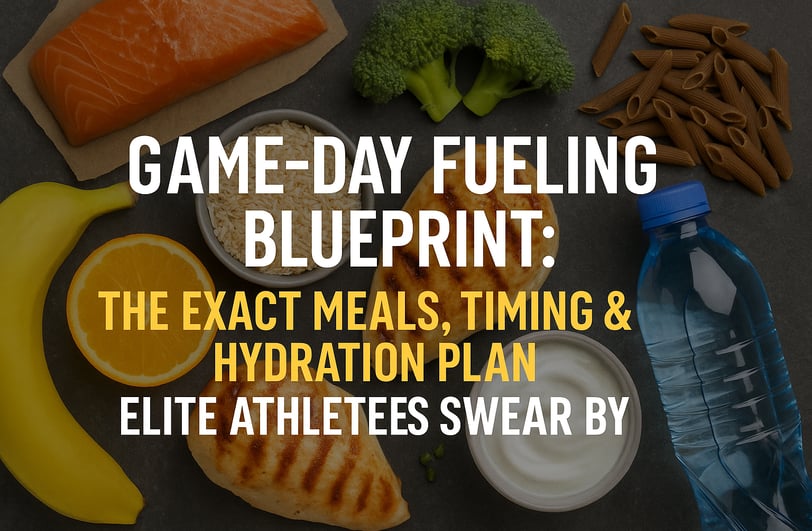Game-Day Fueling Blueprint: The Exact Meals, Timing & Hydration Plan Elite Athletes Swear By
Want to eat like a top-performing athlete? This ultimate guide breaks down exactly what to eat before, during, and after competition—including macros, hydration timing, recovery meals, and supplement safety. Backed by science and real-world application, this isn’t your basic “what to eat” post—it’s your performance playbook.
5/22/20254 min read


Fueling Performance: What a Game‑Day Meal Should Really Look Like
Your complete guide to sustainable energy on game day
Whether you're heading into a crucial soccer match, track meet, or basketball game, what you eat (and drink) can make a real difference. It's not just about feeling full—it’s about fueling the body for peak performance, supporting recovery, and making smart choices under pressure. Here's your playbook:
🕒 1. Pre‑Game Fueling: Timing, Macros & Hydration
When to Eat
3–4 hours before game time: Eat a balanced meal high in complex carbs, moderate protein, and low fat to top off glycogen stores but avoid stomach discomfort Nationwide Children's HospitalBetter Health Channel.
1 hour before kickoff: Choose light carbs like a banana, granola bar, or pretzels plus 8–10 oz of water Nationwide Children's HospitalUChicago MedicineOvertime Athletes Blog.
Macro Breakdown
Carbs (~60%): Whole-grain pasta, rice, sweet potatoes, or fruit help maintain steady energy Johns Hopkins MedicineNationwide Children's HospitalUChicago Medicine.
Protein (~20%): Lean chicken, fish, or Greek yogurt supports muscle repair and satiety Johns Hopkins MedicineNationwide Children's HospitalCloudFront.
Fat (~20%): Include healthy sources like avocado or nuts—but avoid high-fat meals right before the game to minimize bloating Johns Hopkins MedicineVerywell Health.
Hydration Strategy
Drink roughly 500 mL (~17 oz) of fluid 2–4 hours before the game, plus another 8–12 oz about 10–20 minutes before start time Better Health ChannelNationwide Children's HospitalUChicago Medicine.
A handy rule: half your body weight in ounces each day (so a 140-lb athlete would aim for ~70 oz) UChicago Medicine.
Product We Recommend: GU Liquid Energy Gel
Why it shines:
The GU Liquid Energy Gel delivers fast-absorbing carbs in a thin, easy-to-swallow liquid (22g carbs + 190 mg sodium) without needing extra water—perfect during timeouts or quick breaks New York Magazine Amazon.
Best for:
Quick mid-game carb boost and sodium replenishment
Easy digestion during stress or heat
How to use:
Take one 15 minutes before or during play (e.g., at halftime or water breaks). It's isotonic—so no extra water required.
2. During the Game: Keep Going Strong
Refueling Strategy
Short (<60 min) events: Water before and after is usually enough.
Longer or high-intensity games: Sip 6–12 oz of a sports drink every 15–20 minutes—or eat a gel if allowed HealthNationwide Children's HospitalCloudFront.
Electrolytes Matter
Sweating causes sodium, potassium, and magnesium loss—replacing them maintains muscle function and avoids cramps Bon AppétitWikipedia. Look for drinks or gels that list sodium (ideally 100 mg+ per serving) Runner's WorldBon Appétit.
Product We Recommend: Honey Stinger Organic Energy Gel Variety Pack
Why it stands out:
Made with organic honey and tapioca, Honey Stinger gels are gentle on the stomach and provide clean carbs plus electrolytes in a convenient pack—rated loved by marathoners for being stomach-friendly New York PostNew York Magazine.
Best for:
Athletes with sensitive stomachs
Mid-game fueling or cross-training
How to use:
Consume one packet every 30–45 minutes as needed. Test during training to make sure it suits your digestive system Amazon.com.
3. Post‑Game Recovery: Rebuild & Rehydrate
What to Eat
Within 30–60 minutes (the metabolic window)
Opt for carbs and protein in a 3:1 ratio to restore glycogen and jumpstart muscle repair HealthVerywell HealthEat Right.
Examples: Chocolate milk (natural carbs + whey protein), smoothie with yogurt and fruit, or Greek yogurt with granola Children's HealthHealth.
2–3 hours later, eat a full recovery meal: grilled chicken or fish, brown rice or quinoa, and veggies for micronutrients and protein rebuilding UChicago MedicineChildren's HealthCloudFront.
Hydration
Keep sipping water or an electrolyte drink until urine is pale yellow. For heavy sweaters, choose electrolyte-enhanced beverages to replenish sodium and maintain optimal recovery Bon AppétitWikipedia.
Product We Recommend: Science In Sport (SiS) Isotonic Energy Gels
Why it matters:
SiS gels provide 22g fast-acting carbs in an isotonic formula, which means no need for extra water—ideal when pitching or sprints leave you short on hydration timing Amazon.
Best for:
Rapid energy boosts mid-game
Athletes needing quick sodium + carb refueling
How to use:
Take a packet every 45–60 minutes during long games or practices. Because it's isotonic, it's simple and effective.
4. Supplements & Safety on Game Day
Stick with tried-and-tested foods/gels—never test new supplements on game day; testing comes during practice Eat RightOvertime Athletes Blog.
Be cautious with stimulants: some gels contain caffeine, which can enhance focus but may cause jitters or upset stomach. Athletes with sensitivity should choose caffeine-free options New York MagazineNew York Post.
Whole foods first: Supplements like gels, hydration packets, or bars should supplement—not replace—a balanced nutrition plan.
Consult professionals: Dietitians or sports med experts are valuable for personalizing plans, especially for athletes with dietary restrictions or medical conditions.
Final Takeaways
Pre-game: Fuel with complex carbs + protein 3–4 hours ahead, plus hydration. Follow with a light snack 1 hour out.
During: Replenish carbs and electrolytes if the game goes over an hour.
Post: Go for a 3:1 carbs-to-protein snack in the first hour, then follow with a balanced meal.
Hydrate consistently, before, during, and after the game—adjust based on sweat rate and conditions.
Choose wisely: Use tools like GU Liquid, Honey Stinger, or SiS Isotonic gels, but only after testing in training.
Stay safe: Avoid stimulants on game day, track portions, and prioritize whole foods.
With a consistent nutrition and hydration plan—and smart use of tested products—athletes can maximize energy, delay fatigue, support performance, and bounce back stronger post-game. Let your fuel strategy be the play that carries you through the final whistle.
FITNESS
Nutrition
WellnesS
info@movebetterco.com
© 2025. All rights reserved | Privacy Policy | Terms & Conditions